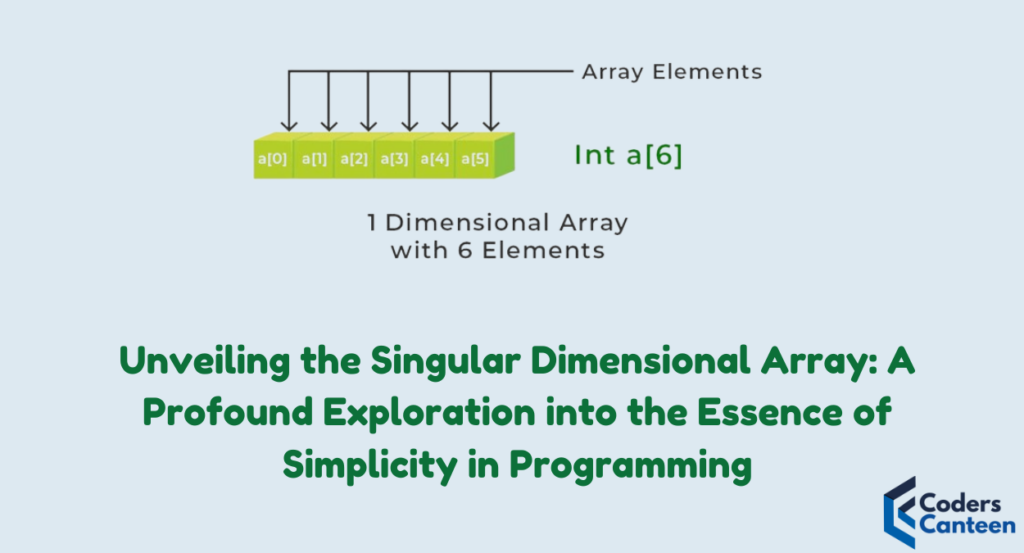In the expansive domain of programming paradigms, where intricacies often prevail, there exists a seemingly unassuming yet profoundly potent entity: the singular dimensional array. This quintessential data structure may ostensibly appear rudimentary, yet its ramifications are as manifold as they are indispensable. Embark with us on an odyssey through the labyrinthine expanse of singular dimensional arrays, wherein we shall unravel its enigmatic intricacies, elucidate its multifarious capabilities, and perhaps, indulge in the occasional mirthful interlude.

Deciphering the Singular Dimensional Array
At its nucleus, the singular dimensional array constitutes a contiguous assemblage of elements, all homogenous in their intrinsic data type. Envision it as a contiguous succession of receptacles, each endowed with the capacity to harbor a discrete datum. These elements are accessed via an index, emblematic of their sequential disposition within the array’s fabric.
Conceive, if you will, a procession of avian specimens, each delineated by a numerical identifier. Such is the essence of the singular dimensional array’s modus operandi.
The Impetus Behind Singular Dimensional Arrays
- Efficiency: Singular dimensional arrays proffer an unparalleled efficacy in the storage and retrieval of data, sans the encumbrance of convoluted data structures.
- Elegance: In contradistinction to their multi-dimensional counterparts or the labyrinthine intricacies of linked lists, singular dimensional arrays exude a prepossessing simplicity, rendering them eminently accessible to neophyte and virtuoso alike.
- Versatility: From the archival of nomenclatures to the meticulous cataloging of inventory items, singular dimensional arrays evince a prodigious versatility, transcending the boundaries of mundane tasks with consummate ease.
Navigating the Utilitarian Landscape of Singular Dimensional Arrays
The instantiation of a singular dimensional array is a meritoriously straightforward affair, encompassing the explicit declaration of the array appellation concomitant with the specification of its dimensionality. Behold, a rudimentary exemplar in the idiom of C:
int scores[5]; // Manifests an array of integers, replete with five discrete elements.The individual elements are accessed through the concatenation of the array denomination with the index, encapsulated within square brackets:
scores[0] = 95; // Prescribes the allocation of the value 95 to the inaugural element of the array.Visualize, if you may, an assemblage of receptacles, arrayed in serried ranks, each bearing an index akin to a bespoke appellation – an allegorical tapestry of data storage, at your beck and call.
Indispensable Operations with Singular Dimensional Arrays
1. Initialization:
The initialization of a singular dimensional array may be effectuated concomitantly with its instantiation:
int numbers[3] = {10, 20, 30}; // Embodies an array of integers, duly populated with predetermined values.2. Traversal:
Traversing the expanse of the array mandates the employment of iterative constructs to access or manipulate each constituent element:
for (int i = 0; i < 3; i++) {
printf("%d ", numbers[i]); // Epitomizes the traversal of the array's precincts, with each element unveiled in turn.
}3. Exploration:
Delve into the array’s domain to scrutinize the presence of specific elements:
int target = 20;
for (int i = 0; i < 3; i++) {
if (numbers[i] == target) {
printf("Element found at index %d\n", i); // Celebrates the fortuitous encounter of the target element within the array.
break;
}
}4. Integration and Abstraction:
Though singular dimensional arrays adhere to fixed dimensions, emulating the processes of integration and abstraction is conceivable through the dynamic repositioning of elements.
Ponder, if you will, a cerebral game of numerical Tetris – wherein the pieces are maneuvered into alignment through deft manipulation.
Must Read:
- How to Solve “Command Not Found: Flutter” – The Ultimate Guide to Flutter Fixes in 2024
- Android Studio-Crush the Frustration: 7 Powerful Tips to Solve ‘Failed to Initialize Editor’ in Android Studio
Frequently Posed Inquiries (FAQs)
Q: Can a singular dimensional array accommodate disparate data types?
A: Regrettably, singular dimensional arrays are constrained to homogenous data types. The accommodation of heterogeneous data necessitates the employment of alternative data structures, such as structs or arrays of pointers.
Q: What befalls one who ventures beyond the array’s confines in quest of elusive elements?
A: The repercussions of extricating elements beyond the array’s purview are manifold and unpredictable, often culminating in the untimely demise of the program. Prudence dictates adherence to the prescribed bounds of the array.
Q: Do singular dimensional arrays proffer a modicum of scalability?
A: Alas, the dimensions of a singular dimensional array are immutable post-instantiation, precluding any semblance of dynamic scalability. For endeavors necessitating such flexibility, recourse to alternative data structures, such as vectors in C++ or ArrayLists in Java, is recommended.
Denouement
In the grand tapestry of programming, simplicity emerges as the lodestar guiding the intrepid voyager. Singular dimensional arrays epitomize this ethos, presenting a seemingly austere yet remarkably potent instrument for data management. Whether traversing the nascent realms of coding or traversing the zenith of technical prowess, mastery of the singular dimensional array shall prove an invaluable asset. Embrace the simplicity, unleash the potential, and watch as your algorithms unfurl like a grand tapestry of computational elegance.
In the labyrinthine corridors of programming, where complexity reigns supreme, let the singular dimensional array stand as your stalwart companion – a beacon of simplicity in an ocean of convolution.